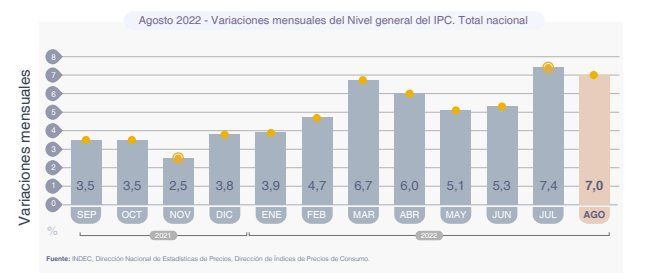inflates August indec.PNG
During August, The rise in the share of prepaid medicine was also highlighted, which had an impact on the Health division (5.7%); of water and electricity services in some regions of the country, which had an impact on Housing, water, electricity, gas and other fuels (5.5%); and mobile telephony services in most regions, which was reflected in Communication (4.1%).
In turn, within Transportation (6.8%) impacted by the rise in public transport fares –higher in the GBA region– and the rise in fuels at the end of the period.
The highest incidence in all regions was provided by the increase in Food and non-alcoholic beverages (7.1%). within the division, the increase in Vegetables, tubers and legumes was highlighted; Sugar, sweets, chocolate, candy; Fruits; Oils, fats and lard; and Milk, milk products and eggs.
inflates August monthly variation indec.PNG

At the category level, Seasonal (8.7%) led the rise –explained, in part, by the aforementioned rises in Clothing and footwear, in Fruits and in Vegetables, tubers and legumes–, followed by the CPI Core (6.8%) and Regulated (6.3%) .
year-on-year changes indece.PNG

It should be remembered that the financial market once again worsened the inflation projection for 2022, and already places it at 95%, according to the Market Expectations Survey (REM) of August 2022, published by the Central Bank.
Market analysts projected that retail inflation for the current year will be 4.8 percentage points higher than the previous survey forecast. In any case, Those who best forecast this variable for the short term (TOP-10) expect an average inflation of almost 100%: 99.4% year-on-year, 4.7 percentage points higher than the July survey.
Likewise, the REM participants revised the inflation forecasts for 2023, placing it at 84.1% yoy (7.6 pp more than the previous REM) and for 2024 at 63.1% yoy (3.1 pp higher than the previous survey). .
Meanwhile, inflation in the Greater Buenos Aires area did not give up in August. The Basic Food Basket (CBA) has risen so far this year by 64% in nearby businesses in the popular neighborhoods of the Conurbano, while so far this year greengrocery products jumped more than 90%, those of warehouse 72% and meat 44%, according to a report prepared by Isaac Rudnik and Juan Fresno, directors of the Institute for Social, Economic and Citizen Policy Research (ISEPCi).
According to the monthly price survey of the 57 products of the Basic Food Basket (CBA) in 900 local businesses in the popular neighborhoods of the Buenos Aires suburbs, in December 2021 a family of two adults and two children needed to acquire their essential food for one month, $31,849.95. Last August, eight months later, he required $52,346.15, that is, 64% more.
While the general rise in prices for registered salaried workers was 6.4% in August, some 0.9 percentage points less than in July, according to the inflation report from the Workers’ Statistics Institute (IET) , of the Metropolitan University for Education and Work (UMET).
In this way, in the first eight months of the year, inflation accumulated 56.4%, while in the last twelve months, the year-on-year rise reached 77%, the highest value since 1991.
News in development…
Source: Ambito
David William is a talented author who has made a name for himself in the world of writing. He is a professional author who writes on a wide range of topics, from general interest to opinion news. David is currently working as a writer at 24 hours worlds where he brings his unique perspective and in-depth research to his articles, making them both informative and engaging.




